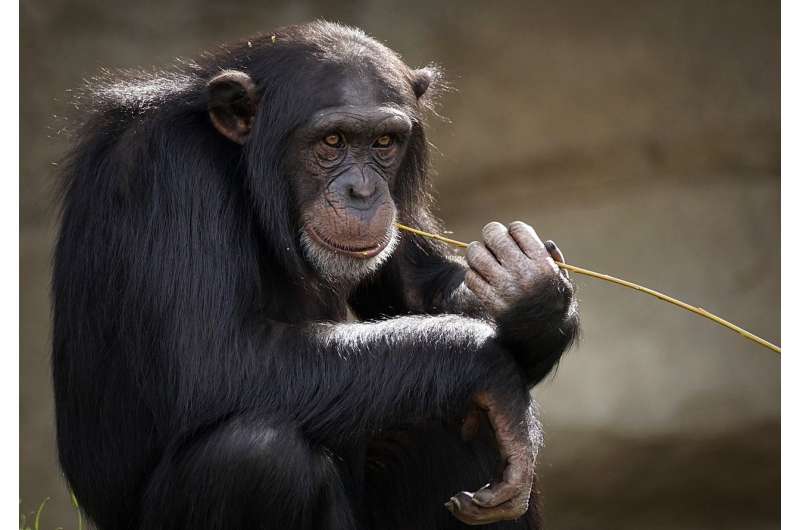This article has been reviewed according to Science X's editorial process and policies. Editors have highlighted the following attributes while ensuring the content's credibility:
fact-checked
trusted source
proofread
Gradual supported release of primates into the wild shown to be effective

Gradually re-introducing primates into the wild with post-release support has, for the first time, been scientifically shown to improve their well-being.
Every year, rescue centers release animals, that are deemed ready, into the wild, based on the assumption that the animals will thrive most in their natural habitat, but this assumption has never been scientifically tested with primates.
A team from Durham University, Disney's Animals, Science and Environment and the Jane Goodall Institute has shown that a group of mandrills, who were returned to the wild using a careful phased approach, adapted well.
After being released back into their natural habitat, the animals' stress response was lower in the wild than it had been when they lived at the sanctuary.
The research is published in the journal Conservation Physiology.
When animals are released into the wild, it is important to keep their stress response low as an animal which is stressed may struggle to thrive in the new environment. This can mean the release fails and the animal must be brought back into human care, or worse, that it doesn't survive.
The study suggests that a carefully planned release, using a pre-release enclosure and varied types of support after release, can work well for wild-born, orphaned mandrills who have been rehabilitated in a sanctuary.
Primate re-introduction guidelines set by the International Union for Conservation of Nature (IUCN) recommend a gradual release and post-release monitoring, but this is often not achieved due to cost and time restrictions.
The authors say their study provides evidence that this very slow and steady process is key to the success of re-introductions and for the well-being of the animals.
The release process involved the mandrills spending time in a pre-release enclosure built in the forest, extra food, observations of the animals' condition, and interventions to remove animals that were not doing well.
Professor Jo Setchell, from the Department of Anthropology at Durham University, led the research. She said, "Many primate releases are conducted based on the assumption that it improves animal welfare, but very few studies have actually tested this.
"Our work applies rigorous science to this assumption, providing evidence that a carefully planned release of mandrills can work well with the right design, monitoring and evaluation."
The rescued mandrills observed in this study had been orphaned by hunting and rescued by the Congolese authorities. Hunting for meat is one of the major threats to mandrill conservation.
Like many primate translocations, this project was primarily motivated by improving primate welfare. Wild mandrills do not yet need population reinforcement. However, with populations of approximately 70 percent of primate species in decline, successful re-introduction will become increasingly important in the future.
Working in the Republic of Congo, the team transferred 15 mandrills from the Tchimpounga Sanctuary to a pre-release enclosure in Conkouati-Douli National Park, and then into the park itself. They collected fecal samples from the mandrills at every stage of the transfer, which they then used to measure their stress response. Using feces allowed the team to measure the mandrills' stress response non-invasively.
The animals' stress response initially increased after their move from the sanctuary to the pre-release enclosure, showing that the move, which involved being transported in crates by car and boat, was stressful, as the researchers expected it would be.
Crucially, however, the mandrills' stress response dropped again over time in the pre-release enclosure, which gave the mandrills a safe place to adjust to their new environment.
To the researchers' surprise, the mandrills' stress response didn't increase when the mandrills were released into the forest.
Just one month after they were released into the wild, the mandrills' stress response dropped below the levels seen while they were in the sanctuary. After one year in the wild, the mandrills' stress response was about half what it had been in the sanctuary, suggesting that the mandrills were doing well in the wild.
Dr. Miles Woodruff was the Principal Investigator of the Mandrill Reintroduction Project at the Jane Goodall Institute who conducted this study as part of his now completed Ph.D. at Durham University.
He said, "This project was ultimately successful because of years of pre-release preparation and extensive post-release support. We went to the extreme lengths to conduct this study because it's important that all releases are learnt from and the results are reported."
"We are dealing with the life and death of critical species in sensitive environments and every individual matters. Our findings are very exciting because we now have physiological evidence to support the 'why' behind the IUCN's suggestions to conduct soft releases of animals."
Of the 15 mandrills released, all survived and two infants were born, but three of the original group were returned to the sanctuary as their transfer was not successful.
More information: Successful acclimatization of mandrills (Mandrillus sphinx) translocated to Conkouati-Douli National Park, Republic of Congo, as measured by fecal glucocorticoid metabolites, Conservation Physiology (2023).
Provided by Durham University



















